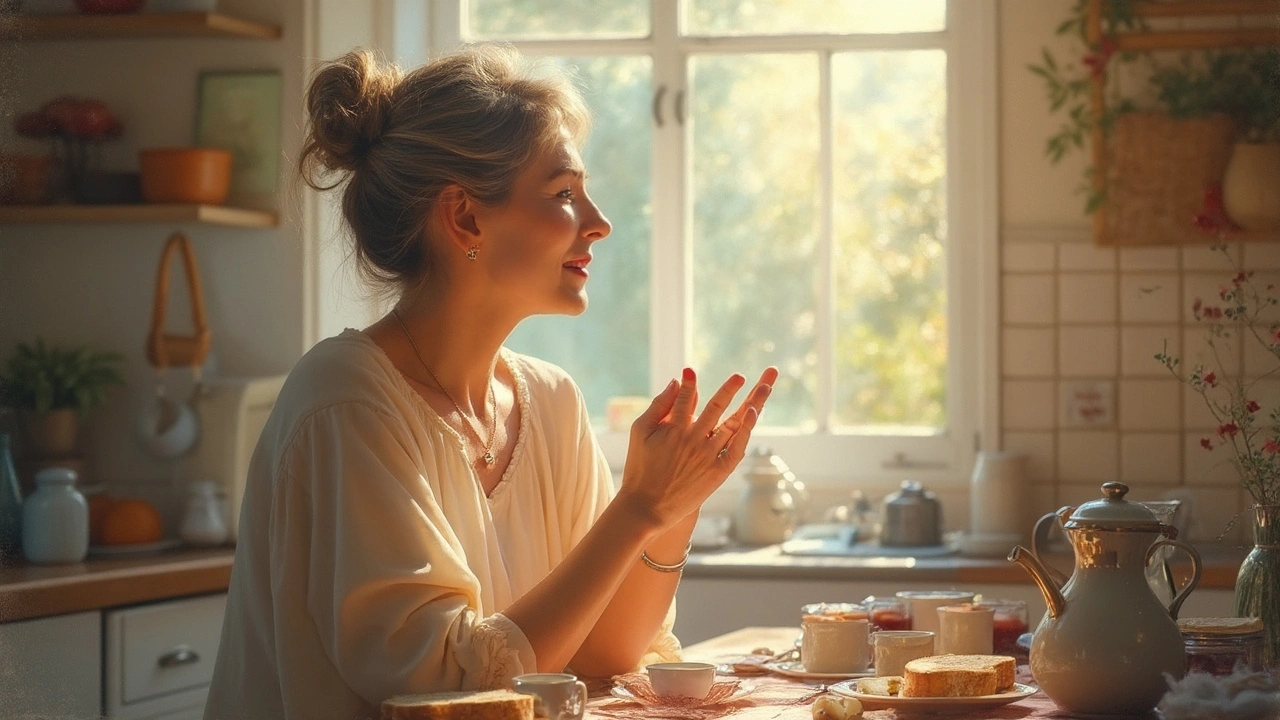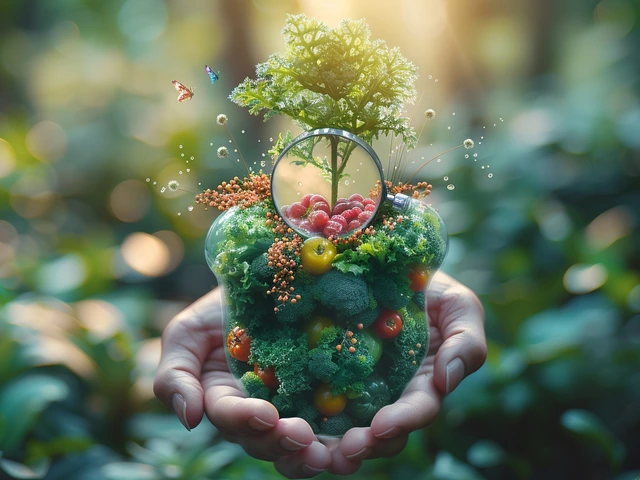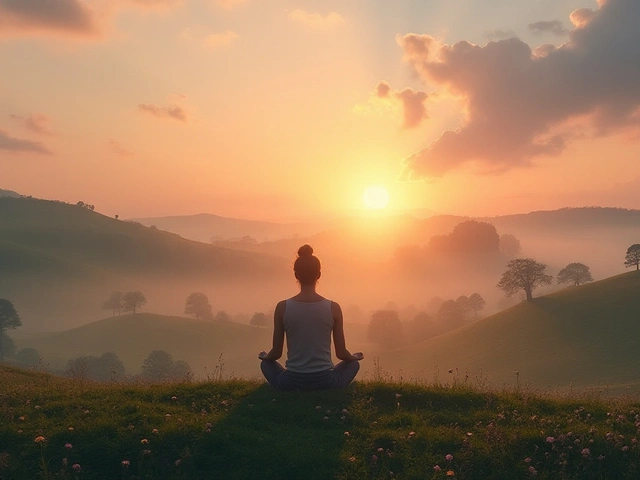
Ever notice how some people seem to glow with calm and happiness, even when life throws curveballs? They're not born with an exclusive luck gene. Most likely, they're tapping into two major forces: mindfulness and gratitude. Weird, right? It’s not some mysterious power—it’s a set of daily choices and small rituals that rewire the brain's chemistry for good. Picture this: a 2023 Harvard Medical School review found that folks practicing regular mindfulness and gratitude reported up to 25% higher levels of self-rated happiness and life satisfaction compared to those who didn’t. Why isn’t everyone doing this every day?
Mindfulness: The Art of Noticing What’s Here
So, let’s unpack mindfulness, a word you see everywhere now—from yoga studios to the side of your cereal box. Mindfulness is about noticing the present, as it is, without scrambling to fix it, worry about what’s next, or obsess over what just happened. Sounds simple? Far from it, especially with a phone buzzing every ten minutes and our brains rehearsing the week ahead. The secret is micro-practices, not some two-hour silent retreat (unless you're into that kind of thing).
Here’s how mindfulness can slip into real life: say you’re pouring your morning coffee—notice the steam, the smell, how the mug feels in your hand. While brushing your teeth, pay attention to the pattern of movements. Even one mindful breath before opening an email can quiet that heartbeat-thumping stress. UCLA’s Mindful Awareness Research Center points to this: just ten minutes daily of focused noticing can shift your brain from panic to presence. Yes, ten measly minutes. Hundreds of studies link mindfulness to lower blood pressure, stronger immune function, and remarkable dips in anxiety rates.
But why does this even work on happiness? When you practice being present, it gets harder for regrets and worries—the biggest mood killers—to hijack your headspace. The brain’s default mode network (the "wandering mind" part) chills out, which means less ruminating on mistakes or anxieties. According to a 2022 survey by the American Psychological Association, 84% of adults who engage in daily mindfulness practices reported feeling more equipped to handle stress and more satisfied with life’s pace.
So how do you really get started, especially if your mind races faster than a caffeine-fueled squirrel? Pick your cues—waiting at a red light, washing dishes, walking to the mailbox. Let these everyday moments become built-in pit stops for noticing your breath or surroundings. Set phone reminders if you have to; trust me, nobody looks at a blinking “Breathe!” alert and thinks you’re weird. Over time, every mindful moment stacks up and teaches your brain to hit pause—so you’re not always sprinting into the next worry or task. Even athletes and CEOs are publicly using mindfulness to stay steady in wild situations. The best part? You don’t need any gear, apps, or fancy routines. You just start where you are.
| Mindfulness Benefit | Research Highlight |
|---|---|
| Reduced Anxiety | 62% less self-reported anxiety after 4 weeks of daily practice (Stanford, 2021) |
| Lower Blood Pressure | Average drop of 6-10 points for participants in daily mindfulness groups (JAMA, 2022) |
| Increased Focus | 83% improvement in task completion and sustained attention (UC Berkeley, 2023) |
Stick with it daily, especially when everything feels chaotic. The real magic is how quickly your nervous system learns new tricks. "Mindfulness is a way of befriending ourselves and our experience," says Jon Kabat-Zinn, a leading mindfulness researcher. That's not just a nice bumper sticker—it's real.

Gratitude: Training Your Brain for Goodness
Gratitude gets called the quickest happiness hack—but that’s selling it short. It’s not about ignoring problems or pretending everything is perfect. Gratitude is seeing the full picture and still deciding to focus on what’s working. University of California, Davis, psychologist Robert Emmons, who’s published decades of research, says: “Gratitude blocks toxic emotions such as envy, resentment, and depression.” His team found that people keeping a daily gratitude journal reported feeling happier and even slept better after just three weeks.
So, gratitude isn’t some pie-in-the-sky attitude. It’s concrete. You can build the skill in bite-sized pieces:
- Keep a quick gratitude list. Each night, jot down three things that weren’t a disaster, no matter how tiny—like hot water or a dog that made you laugh.
- Give specific thanks. Say it to someone’s face, text it, or even just think it. Being detailed works better: instead of “thanks for dinner,” try “thanks for making pasta; it hit the spot after my awful day.”
- Reframe setbacks. Didn’t land a job? Maybe you learned a new interview skill. Got stuck in traffic? Extra time for your favorite podcast.
- Use visual triggers—a sticky note on the fridge or a photo on your phone wallpaper to cue thankfulness.
People who practice this aren’t forcing fake cheerfulness. They’re expanding their view, so good things aren’t crowded out by the grind. And the brain starts to tilt that way naturally: MRI research out of Indiana University in 2023 showed that gratitude practices boost neural activity in the prefrontal cortex—the same area tied to decision-making and positive emotions. Even more convincing: a 2024 Gallup Poll revealed 70% of adults who build a daily gratitude routine feel more optimistic about the future, despite stress and uncertainty everywhere.
Every culture has some version of gratitude rituals, whether that’s saying thanks before a meal, or writing ‘thank you’ notes, or celebrating moments with friends. Turns out, these aren’t just good manners—they’re clever hacks that keep the brain on the lookout for moments of meaning. The biggest trick? Make gratitude visible and concrete. Put your three best moments of the day on a note where you'll see them. Thank someone out loud. Share stories at dinner about what went right. Each moment of gratitude builds a habit loop, nudging your mood higher day by day.
“The roots of all goodness lie in the soil of appreciation for goodness.” – Dalai Lama
Keep this up and life’s frustrations stop feeling like the main headline. Instead, the highlights get some airtime too.

The Happiness Effect: Building Sustainable Joy with Mindfulness and Gratitude
Here’s where things get powerful: mixing mindfulness and gratitude cranks up the benefits of each even higher. It’s like cross-training for your mind. When you’re mindful, you notice the small wins; when you’re grateful, you absorb them better. This dynamic duo resets your whole outlook—even when conditions around you stay messy.
Imagine waking up. First thing, you check in with yourself—how’s your body? What are you feeling? Doesn’t matter if it’s groggy or energized, just notice it mindfully. Then while you sip coffee, think of something you appreciate in that exact moment—maybe warmth of the mug or a favorite song on the radio. That’s it. The day’s already starting with less autopilot and more choice. A 2023 study from Yale University pinpointed that layering mindfulness and gratitude together for even five minutes lowers stress hormones (cortisol) by up to 18% by noon. Want those effects to last all day? Pair a gratitude ritual right after a mindful breath at natural pauses—after lunch, before bed, waiting in the car line.
This approach works because your brain thrives on patterns. Just like negative thinking can spiral quickly, so can positive habits—if you repeat them and celebrate small wins. Try making a "mindful moment jar"—each time you notice something good or pause to breathe, toss in a note or bead. At week’s end, see the proof. You’ll likely find your stress responses drop, patience stretches, and random bursts of happiness show up more often. The National Institutes of Health backed this concept, with research showing that adults who tracked both mindful pauses and daily gratitudes showed a 40% increase in what psychologists call “authentic happiness” after two months.
But don’t freak out if it feels weird or clunky at first. Our brains are built to spot trouble (thanks, survival instincts). It takes real practice for the positive stuff to cut through the noise. Miss a day? No sweat; it hasn’t all gone to waste. Like any habit—think exercise or flossing—consistency beats perfection. The real key is letting simple moments add up. Instead of viewing joy as some rare event, you see it as a steady flow of small, honest pleasures. Over time, this changes everything from how you handle setbacks to the way you treat other people.
So, if you’re tired of riding the rollercoaster of highs and lows, here’s the hack: start stacking mindful moments and concrete gratitudes as you go. Use your senses as anchor points, name good stuff out loud, share what you’re thankful for with someone, or keep a running note on your phone. Life might stay unpredictable, but your brain and mood get much steadier ground to stand on. Real, lasting happiness isn’t about fixing every problem; it’s about changing the way you see the ones you have. And, weirdly enough, your brain’s happiness circuits are ready to build that new path—one small, mindful, grateful step at a time.





